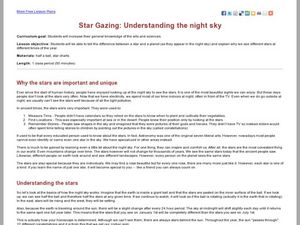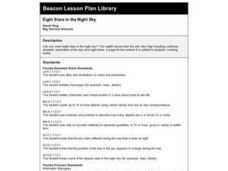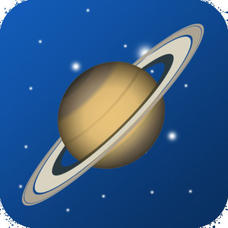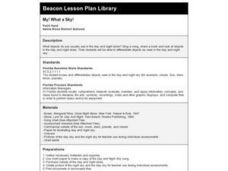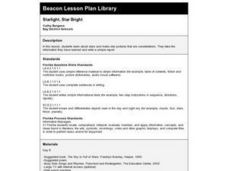Curated OER
Sky Observation Project
In this sky observation worksheet, students make observations of the night sky and use their planisphere and star charts to help identify what they observe. They make observations and record what they see for 10-15 minutes. They draw a...
Curated OER
Sky Stories
Students are introduced to the branch of science known as astronomy. They discuss stars and constellations and then view the night sky using a portable digital planetarium projector. They identify a variety of constellations and...
Curated OER
Star Quest
Young scholars review the concepts of the branch of science known as astronomy. They discuss stars and constellations and then view the night sky using a portable digital planetarium projector. They identify a variety of constellations...
National Center for Case Study Teaching in Science
Mask of the Black God
Finally, an astronomy lesson for the high schooler! Explorers are able to read star maps for finding objects in the night sky by determining celestial coordinates. In particular, they locate the Pleiades and read about a Navajo legend...
Curated OER
Star Gazing: Understanding the night sky
Young scholars observe star charts to understand the difference between a star and a planet. In this star lesson plan, students also explain why we see different stars at different times of the year.
Curated OER
Eight Stars in the Night Sky
First graders explore the day and night sky. They complete a number 8 page for their counting books.
Q Continuum
Planets
Have you ever looked up at the night sky and wondered what constellation you were seeing or whether that bright object was a star or a planet? Are you searching for the best tilt-to-view constellation and planet app that money can't buy?...
Starry Night Education
The Stars
Three astronomy activities in one resource! Here you will find one hands-on activity, one demonstration, both with discussion questions, and one activity worksheet. During these lessons young scientists discuss how stars are...
Curated OER
What Stars Can You See?
For this stars worksheet, students will fill in the blank of 4 fact statements about the sun and 4 fact statements about other stars in the sky.
Curated OER
The Night Sky
Third graders develop questions they have about the solar system. After being read a book, they view and discuss different constellations in the sky. In groups, they are given a piece of butcher paper and glow in the dark crayons in...
Curated OER
Sky Quest: Exploring the Constellations
Students examine constellations and planets through completing various activities. Students work individually and in groups to create drawings based on stars, compare and contrast the night sky with and without a telescope and learn...
Curated OER
Zodiac Constellations
In this space science worksheet, students learn to identify the 12 constellations of the Zodiac. Students read the information and look at the detailed drawings of each constellation and when it is visible in the night sky.
Curated OER
Our Sky Clock
Young scholars explore space science by completing a worksheet in class. In this astronomy lesson, students discuss and identify star patterns in the night sky and relate these patterns to the approximate time they appear. Young scholars...
American Museum of Natural History
A Kid's Guide to Stargazing
Get kids interested in stargazing with a step-by-step guide. The guide begins with the do's and don'ts, what the defines a star, and introduces a journal. The page is linked to see stars if light pollution keeps stars away in your area.
California Academy of Science
Paper Cup Planetarium
Bring the night sky to your classroom! Using simple materials, learners create flashlight constellations on the wall. They then use their imaginations to create their own star patterns that tell a story.
Curated OER
"Twinkle, Twinkle, Little Star"
Second graders sing the son "Twinkle, Twinkle, Little Star." They are asked:"How many of you have looked at the stars in the sky on a clear night? Have you ever wished on a star? What did you wish?" Students are explained the concept...
Curated OER
Stars and Constellations
Ninth graders investigate how ancient cultures viewed their world in terms of astronomy. They read and discuss an informational handout, construct an astrolabe, and locate stars and constellations using star charts.
Curated OER
Stars and Constellations-Pattern Recognition
For this stars and constellations worksheet, students study a given constellation and identify the stars in the constellation. They label the stars in the constellation and identify the months the constellation is visible. They research...
Curated OER
My! What a Sky!
First graders read "Goodnight Moon" or "Day And Night" and discuss what they see in day and night skies. They read and sing lyrics to the "Day and Night" song. They identify objects in the sky as day or night objects. They illustrate day...
Curated OER
Starry, Starry Night
Students, using construction paper, and an empty black film canster with no lid, create their own night sky full of stars that can be seen in the middle of the day.
Curated OER
Starlight, Star Bright
First graders read books and use the Internet to identify several constellations and stars in the night sky. They make star pictures and write a class report about the night sky including a title, complete sentences and a cited reference.
Curated OER
Let the North Star Tell You Where You Are
Students create an astrolabe and locate the North Star in the night sky. They determine the latitude of the North Star, and calculate an average latitude based on class results.
Curated OER
Navigation By the North Star: A Lesson Plan in Four Parts
Students investigate why the North Star was important for navigation, how stars move across the night sky, how to locate the North Star, how to make a crude sextant, and how to determine latitude using a sextant and the North Star. They...
Curated OER
Star Stories
Students study constellations and the stories that go with them. They identify at least 3 constellations in the night sky. Students recognize some of the myths surrounding the constellations. They create their own constellation and myth.






